 |
|
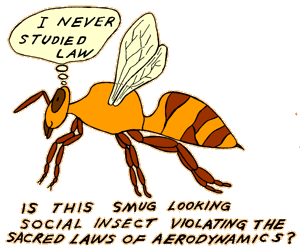
Being somewhat snobby, unimaginative, and totally lacking in curiosity (quite
unlike turtles), they think they don't need to know anything else.
However, as lawyers and judges tell us, ignorance of the law is no excuse. That's
why it won't do you any good to tell the judge you didn't know you were breaking
the speed limit when you were going 55 miles per hour in a 35 mile per hour zone.
You were ignorant of the law (or really not paying attention) but you still gotta
pay.
|
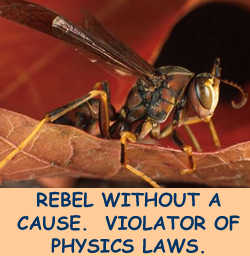 Ignorance of the law is even
less of an excuse when it comes to the laws of physics. Whether or not you understand
the law of gravity, or know it exists, or even believe in it, you will obey it.
If you step off the roof of a house, the force of gravitational attraction, exerted
between your body and the earth's body, will pull you toward the ground at an
increasing speed which is clearly and precisely predicted by a formula easily
found in any physics text book. (Of course, on planets with an atmosphere, like
earth, air resistance will affect this acceleration process and slow you down
somewhat, but alas, not quite enough.)
Ignorance of the law is even
less of an excuse when it comes to the laws of physics. Whether or not you understand
the law of gravity, or know it exists, or even believe in it, you will obey it.
If you step off the roof of a house, the force of gravitational attraction, exerted
between your body and the earth's body, will pull you toward the ground at an
increasing speed which is clearly and precisely predicted by a formula easily
found in any physics text book. (Of course, on planets with an atmosphere, like
earth, air resistance will affect this acceleration process and slow you down
somewhat, but alas, not quite enough.)
So, whether or not the bees have studied law, they still have to always
obey the laws of physics, which include whatever so-called "laws of aerodynamics"
they have not studied.
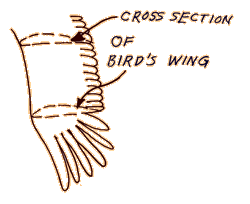 But let's be fair
to the humans who say such slightly foolish things. It is true that the aerodynamic
mechanisms that insects use to dart about in the air are different in some significant
ways than the mechanisms that birds and airplanes use to flit (in the case of
sparrows and finches), or lumber (in the case of big cargo planes and human powered
gossamer albatrosses), or soar (hawks and buzzards), or dart (humming birds),
through the air. It is also true that scientists and engineers have only in recent
years begun to understand the very complicated mechanisms of insect aerodynamics.
The basics are better understood now, and more is being learned, but it is still
not fully understood. However, not understanding all the details of how something
works doesn't mean the explanation must be magic. Let me say that again. Not fully
understanding how something works does not mean the explanation must then be magic
(nor does it mean the only possible explanation is aliens from another planet).
A violation of the normal laws of physics would be magic or a miracle. But let's be fair
to the humans who say such slightly foolish things. It is true that the aerodynamic
mechanisms that insects use to dart about in the air are different in some significant
ways than the mechanisms that birds and airplanes use to flit (in the case of
sparrows and finches), or lumber (in the case of big cargo planes and human powered
gossamer albatrosses), or soar (hawks and buzzards), or dart (humming birds),
through the air. It is also true that scientists and engineers have only in recent
years begun to understand the very complicated mechanisms of insect aerodynamics.
The basics are better understood now, and more is being learned, but it is still
not fully understood. However, not understanding all the details of how something
works doesn't mean the explanation must be magic. Let me say that again. Not fully
understanding how something works does not mean the explanation must then be magic
(nor does it mean the only possible explanation is aliens from another planet).
A violation of the normal laws of physics would be magic or a miracle.
Actually, what you normally hear about this issue is not that bees are violating
the laws of aerodynamics, but rather that scientists can't explain how bees fly,
or that engineers have proven, according to the laws of aerodynamics, that bees
can't fly.
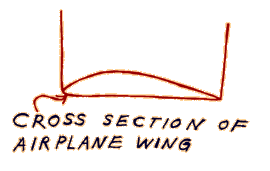
Here is the basis of the problem:
Conventional aerodynamic calculations are relatively simple, being based on large
fixed wings and steady state or quasi-steady
state flow.
Insect wings are small, flat, rough surfaced, and flexible. During flight they
flex and twist in all kinds of horribly complicated ways. Also they are so small
that important dimensional fluid analysis numbers like
the Reynold's Number are very different, resulting
in significantly different fluid characteristics when compared to the bigger wings
of birds and airplanes (even a sparrow wing is huge compared to most insect wings).
In addition, the small size and high speed of most insect wings makes it very
difficult to study insect flight (imagine trying to attach a pressure sensor to
an insect wing). Finally, the pressures and flow characteristics of the air around
the wings are very unsteady, constantly changing as the wind flaps, bends, and
twists, unlike aircraft wings which are stiff with relatively simple constant
flow patterns and pressures.
Conventional aerodymic analysis methods simply don't
apply to insect wings.
 Big
deal! It doesn't mean bees can't fly, or that engineers say they can't fly. It
just means that insect flight is very complicated and, even with computers, our
fluid dynamic modeling techniques aren't yet able to quite handle such a complicated
problem. Then there's the problem of verification. If you can't measure the pressures
and velocities around a wing, how can you verify your calculations? Big
deal! It doesn't mean bees can't fly, or that engineers say they can't fly. It
just means that insect flight is very complicated and, even with computers, our
fluid dynamic modeling techniques aren't yet able to quite handle such a complicated
problem. Then there's the problem of verification. If you can't measure the pressures
and velocities around a wing, how can you verify your calculations?
I can tell you from my days of developing diesel engine turbochargers there are
lots of fluid dynamics problems where computer modeling is not yet able to accurately
analyse or predict the flow. Yet, people don't go around saying, "Gee willickers,
engineers have proven turbochargers can't work".
Diesel engine combustion is another area that is presently too complicated to
model except with greatly oversimplified models based largely on experimental
data. Does that mean engineers have proven fuel can't burn in diesel engines?
Hec no. It just means we don't fully understand it yet.
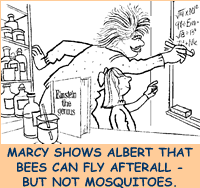 Tornadoes
aren't fully understood. If incorrect analysis methods fail to accurately predict
tornadoes, does that mean science has proven they don't exist? Tornadoes
aren't fully understood. If incorrect analysis methods fail to accurately predict
tornadoes, does that mean science has proven they don't exist?
We have hardly scratched the surface on understanding the incredibly complex human
body. But do you hear people going around saying scientists don't know everything
about the human body, therefore, it must be impossible for the human body to function?
Mysteries don't prove science is bunk. They are the reason for science. If there
were no mysteries there would be no need for science. There are many mysteries
in science a lot more difficult than the flight of insects. I am quite certain
we will understand insect flight much sooner than we will understand the human
body.
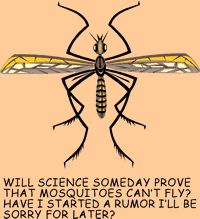 Now
for a brief digression. The story of how some scientist or aerodymic engineer
proved bees or insects can't fly is, I think, an urban myth. An urban myth is
a story that is repeated over and over by all kinds of references and is assumed
by everyone to be true because they heard it someplace else, sometimes even in
books, magazines, news reports, etc. But, in fact, it is not true. I have researched
this urban myth a little through the years and found many different versions of
how it came about. None of them were verifiable, but at least one was supposedly
based on the testimony of some reputable individuals who were there at the birth
of one of these stories. Since it is typical, I will tell it here. Now
for a brief digression. The story of how some scientist or aerodymic engineer
proved bees or insects can't fly is, I think, an urban myth. An urban myth is
a story that is repeated over and over by all kinds of references and is assumed
by everyone to be true because they heard it someplace else, sometimes even in
books, magazines, news reports, etc. But, in fact, it is not true. I have researched
this urban myth a little through the years and found many different versions of
how it came about. None of them were verifiable, but at least one was supposedly
based on the testimony of some reputable individuals who were there at the birth
of one of these stories. Since it is typical, I will tell it here.
One typical urban myth explanation of the "Bees Can't
Fly" story:
"Once upon a time some scientists and engineers or college professors (different
versions have different names and specialties) were at a dinner party. The subject
of bee flight came up and the aerodynamic engineer that just happened to be present
decided to do a quick calculation on bee aerodymics. He used a conventional stiff
airfoil-shaped wing, with steady state, or partially steady state, air flow analysis
techniques, and lo and behold, the calculations did not work for the bee. Someone
jokingly said, "I guess that proves bees can't fly", and they all had
a good laugh. But, of course, they all knew it just proved that bee flight is
too complicated to analyse with conventional airplane aerodynamic methods."
Unfortunately the story spread in its many inaccurate forms and, to borrow from
Jonathan Swift, it appealed to peoples' "nut notes". It caught on -
bad luck for science, good luck for inspirational speakers and science nay-sayers.
|
| Well, I doubt
if that story is true. It may be that something like that really happened, or
has happened in various forms more than once. |
|
|
However, I do not believe that any knowledgeable scientist or aerodynamics engineer
ever seriously and straight faced claimed they have proven insects can't fly,
or that insects violate the laws of physics. It's just plain silly. |
|
 |
| Dragonflies fly fantastically
well with flat rough wings, but these wings wouldn't work very well for bigger
animals and man-made planes. |
|
| |
 |
 |
 |
Next, Dr.
Galapagos discusses deep diving sperm whales:
Go to next question
Comments or suggestions for
Dr. Galapagos?
Top of This Page
FT Exploring Home Page
Site Navigation Page
|
|
 |
|
|